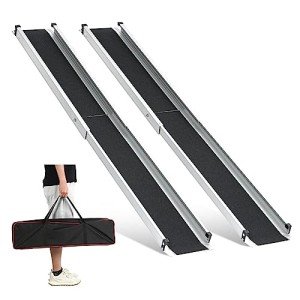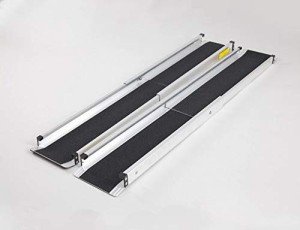In today's society, access to mobility and independence for individuals with disabilities is paramount. A significant aspect of this is ensuring that individuals who rely on wheelchairs can navigate their environments with ease. One innovative solution that has emerged to address this need is the telescopic wheelchair ramp. This guide delves into the features, benefits, and considerations of telescopic wheelchair ramps for easy access, providing an informative guide for both users and caregivers.
Understanding Telescopic Wheelchair Ramps
Telescopic wheelchair ramps are designed to provide a portable and adjustable accessibility solution for individuals who need to overcome obstacles such as stairs, raised door thresholds, and other inclines. Unlike traditional ramps, which are often fixed in place, telescopic ramps can be extended and retracted to vary their length, making them adaptable for various settings and heights.
Key Features of Telescopic Wheelchair Ramps
-
Adjustability: The primary feature of telescopic ramps is their ability to adjust to different lengths and heights. Most models can extend to accommodate a range of elevations, making them suitable for diverse situations.
-
Portability: Telescopic ramps are generally lightweight and foldable, making them easy to transport. They can be stored in cars, homes, or other locations without requiring much space.
-
Durability: Constructed from high-quality materials like aluminum or steel, these ramps are designed to withstand regular use and various weather conditions, ensuring reliability.
-
Non-slip surface: Many telescopic ramps feature a textured surface that provides traction, reducing the risk of slips and falls during use.
-
Safety features: Most models come equipped with side rails or edges to prevent wheelchairs from rolling off during ascent or descent, enhancing safety for users.
Benefits of Telescopic Wheelchair Ramps
The introduction of telescopic wheelchair ramps provides numerous advantages for users and caregivers alike:
1. Increased Accessibility
Telescopic ramps break down physical barriers by allowing individuals using wheelchairs to access buildings, vehicles, and outdoor spaces that might otherwise be unreachable. This increased mobility fosters independence and a sense of control over one’s environment.
2. Cost-effectiveness
In many cases, installing permanent ramps can be an expensive undertaking, particularly in residential or commercial properties with limited space. Telescopic ramps offer a more affordable, flexible solution that can be adjusted according to specific needs.
3. Versatility
These ramps can be used in a variety of situations, including:
- Home entrances: Providing access to front doors or back patios.
- Vehicle loading: Allowing easy loading and unloading into vans or trucks.
- Public places: Facilitating access to parks, shops, and community centers.
4. Encouragement of Participation
By improving accessibility, telescopic ramps encourage individuals with mobility challenges to participate in community activities, social events, and family outings, contributing positively to their quality of life.
Choosing the Right Telescopic Wheelchair Ramp
When selecting a telescopic wheelchair ramp, several factors should be considered to ensure it meets the user’s specific needs:
1. Weight Capacity
It is crucial to select a ramp that can support the weight of both the wheelchair and the user. Most ramps specify a maximum weight limit, which should always be adhered to for safety.
2. Length and Height
Evaluate the height of the stairs or the incline that the ramp will be used for. Manufacturers typically provide guidelines on which ramp length is suitable for different heights.
3. Material
Choose a ramp made from durable materials like aluminum, which are lightweight yet strong. Consider corrosion-resistant options if the ramp will be exposed to the elements.
4. Surface Type
Opt for ramps with non-slip surfaces, especially if the ramp will be used outdoors or in wet conditions. Textured surfaces enhance safety by providing better grip.
5. Portability
If transport is a necessity, consider the weight and folding capabilities of the ramp. Ensure that it can easily fit into the trunk of a vehicle or be stored away in tight spaces.
6. Additional Features
Look for ramps with added safety features, such as side rails, and ensure they are easy to set up and dismantle.
Telescopic wheelchair ramps represent a significant advancement in providing accessibility and independence for individuals with mobility challenges. Their versatility, ease of use, and safety features make them a practical solution for navigating various environments. As society increasingly recognizes the importance of inclusivity for all individuals, these ramps will likely remain a pivotal tool for enhancing mobility and quality of life.
FAQs
Q: How do I maintain my telescopic wheelchair ramp?
A: Regularly inspect the ramp for any signs of wear and tear, such as corrosion or damaged surfaces. Clean the ramp with mild soap and water to keep it in optimal condition.
Q: Can telescopic ramps be used for heavy-duty applications?
A: Yes, many models are designed to accommodate larger weights, but always check the weight limit and choose a ramp that suits the user's specific needs.
Q: Are telescopic wheelchair ramps suitable for outdoor use?
A: Yes, they are often made with weather-resistant materials, but it's wise to consult the manufacturer's recommendations for outdoor usage.
Q: Can I use a telescopic ramp for a car?
A: Yes, telescopic ramps are often used to facilitate loading wheelchairs into vehicles. Ensure you select a length that accommodates the height of your vehicle.






